
Lizards are a widespread group of squamate reptiles, with over 7,000 species, ranging across all continents except Antarctica, as well as most oceanic island chains. The group is paraphyletic since it excludes the snakes and Amphisbaenia, although some lizards are more closely related to these two excluded groups than they are to other lizards. Lizards range in size from chameleons and geckos a few centimeters long to the 3-meter-long Komodo dragon.

The greater earless lizard is the only species in the monotypic genus Cophosaurus. It is closely related to the smaller, lesser earless lizards and other species in the genus Holbrookia, and in fact was placed in that genus and referred to Holbrookia texana from 1852 into the 1970s. Earless lizards lack external ear openings, an adaptation to burrowing in the sand, as are the recessed lower jaw and flared upper labial scales. Greater earless lizards are sexually dimorphic, males grow larger and are more colorful than females, exhibiting pink and green colors that are particularly bright in the breeding season. Two bold black bars mark the lateral region of males but are greatly reduced and vague, or occasionally entirely absent in females.

Xantusia () is one of three genera of night lizards. Species of Xantusia are small to medium-sized, viviparous (live-bearing) lizards found in the U.S. Southwest and in northern Mexico. These lizards display morphological adaptations to specific microhabitats. They occupy rock crevices and decaying plants. Rock dwellers generally have brighter coloration, longer limbs and digits, and larger size than plant dwellers, which are generally duller, smaller, and have shorter limbs.
Species of the genus Xantusia are remarkably disjunct, with populations scattered throughout the deserts and mountains of the far western borderlands with only a handful of recorded cases of interspecific allopatry. The genus contains at least seven distinct cases of morphological convergence to the rock dwelling ecomorph in Arizona, California, Baja California, and Central Mexico.

The island night lizard is a species of night lizard native to three of the Channel Islands of California: San Nicolas Island, Santa Barbara Island, and San Clemente Island. A small number of island night lizards also live on Sutil Island, near Santa Barbara Island.

The slender glass lizard is a legless lizard in the glass lizard subfamily (Anguinae). The species is endemic to the United States. Two subspecies are recognized. The lizard was originally believed to be a subspecies of the eastern glass lizard. Their name comes from their easily broken tail which they can break off themselves without ever being touched. It is difficult to find a specimen with an undamaged tail. The lizard eats a variety of insects and small animals, including smaller lizards. Snakes and other animals are known to prey on the species. Humans have a part in destroying their environment and killing their food supply with insecticides. The lizard is considered to be a least-concern species according to the International Union for Conservation of Nature (IUCN), though it is vulnerable in Iowa and endangered in Wisconsin. It is important to note that the streamlined, legless species is often confused with snakes. Glass Lizards, however, differ from snakes as they possess a moveable eyelid, which is absent in snakes. Another way to distinguish glass lizards from snakes is the presence of an external ear opening, which are absent in snakes.

The western skink is a species of small, smooth-scaled lizard with relatively small limbs. It measures about 100 to 210 mm in total length. It is one of seven species of lizards in Canada. They spend much of their day basking in the sun. Their diet ranges widely, including spiders and beetles. Western skinks will bite if grasped and will flee if they feel threatened. It is a common but secretive species whose range extends from southern British Columbia and throughout Washington, Oregon, Nevada, Utah, Idaho, and Wyoming and into western Montana and northern Arizona and Missouri. They can also live in some areas of Texas It is widespread in northern California but primarily restricted to the coast in central and southern California. Found in a variety of habitats, this lizard is most common in early successional stages or open areas of late successional stages. Heavy brush and densely forested areas are generally avoided. Western skinks are found from sea level to at least 2,130 m (7,000 ft). This diurnal reptile is active during the warm seasons.

Night lizards are a group of small scincomorph lizards, averaging from less than 4 cm (1.6 in) to over 12 cm (4.7 in) snout–vent length. Most species are viviparous (live-bearing), with the exception of those in the genus Cricosaura. The family has only three living genera, with approximately 34 living species. The genera are divided by geographic range: Xantusia in southwestern North America and Baja California, Cricosaura in Cuba, and Lepidophyma, the most populous night lizard genus, in Central America. Three fossil genera are also known: Catactegenys, Palepidophyma, Palaeoxantusia.
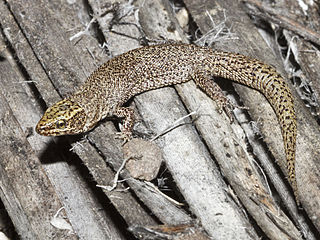
The desert night lizard is a night lizard native to the Southern California Eastern Sierra and the San Gabriel Mountains into Baja California, southern Nevada, southwestern Utah and extreme western areas of Arizona.

Chuckwallas are lizards found primarily in arid regions of the southwestern United States and northern Mexico. Some are found on coastal islands. The five species of chuckwallas are all placed within the genus Sauromalus; they are part of the iguanid family, Iguanidae.
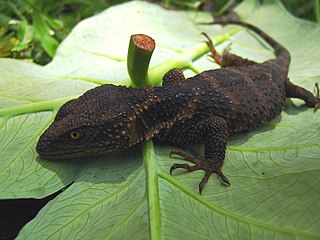
Xenosaurus grandis, commonly known as the knob-scaled lizard, is a species of diurnal, terrestrial lizard endemic to Mexico and Guatemala. It primarily inhabits tropical rainforests. It dwells in rock crevices and eats insects.
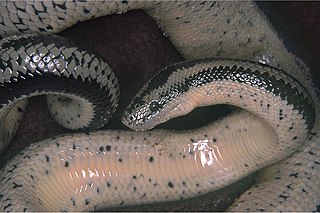
The desert rosy boa is a species of snake in the family Boidae. The desert rosy boa is native to the American Southwest and Baja California and Sonora in Mexico. The desert rosy boa is one of four species in the boa family native to the continental United States, the other three being the coastal rosy boa and the two species of rubber boas (Charina).
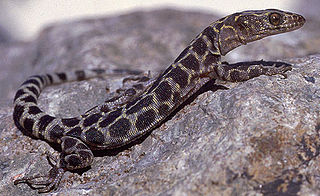
The granite night lizard is a species of xantusiid lizard endemic to North America.

Bezy's night lizard is a species of lizard in the family Xantusiidae. The species is endemic to Arizona.
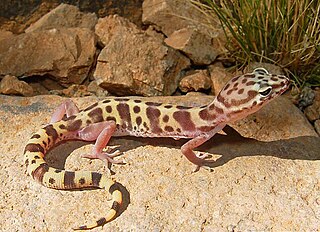
The western banded gecko is a species of lizard in the family Eublepharidae. The species is native to the southwestern United States and adjacent northwestern Mexico. Five subspecies are recognized.
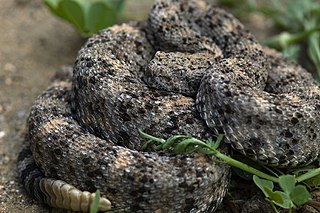
Crotalus pyrrhus is a venomous pitviper species found in the southwestern United States and northwestern Mexico. A medium-sized snake, it is found mostly in rocky country, active at night and feeding on small mammals. The coloration is variable and depends on the color of the rocks and soil of the habitat.
The bolsón night lizard is a species of night lizard in the family Xantusiidae. The species, which was originally described by Robert G. Webb in 1970, is endemic to the state of Durango in Mexico. Not much is known about the lizard at present, as it appears to be simultaneously rare and rather secretive in nature.














